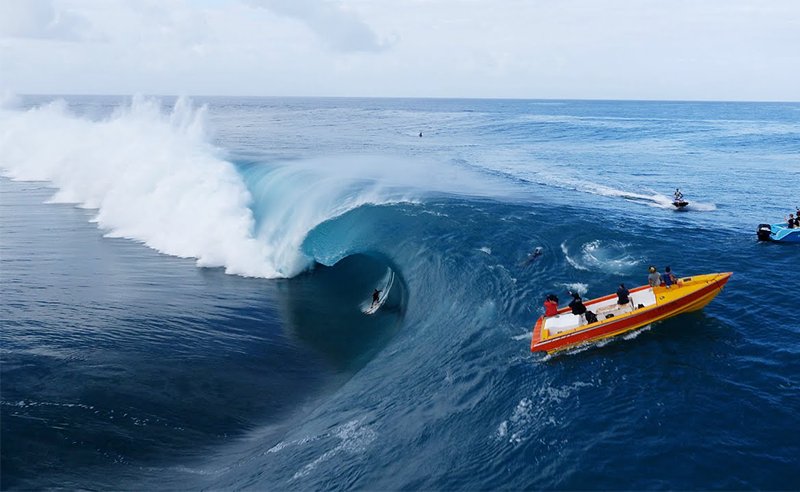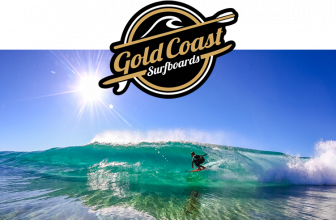
Many spend a good chunk of our lives diving and surfing into the magnificent waves that Mother Nature provides.
Although they may seem magical, waves don’t just break out of thin air.
More...
“Okay, so why do waves break then?”
Many processes go behind the breaking of waves and we can study them using what scientists refer to as fluid dynamics. Fluid dynamics is a specific discipline within the realm of physics that studies the movement of liquids and gases. To understand the breaking of a wave, we must first understand where waves come from.
Overview
Waves move from the deep sea towards the shore thanks to the wind. As they eventually reach shallower waters, the bottom parts of the waves decrease in speed.
Because the top of the wave continues to move at the same speed, it eventually is moving too fast and spills over, creating the break that us surfers know and love! A typical wave will start breaking when the ratio of the height to wavelength exceeds 1:7.
Essentially, if a wave with a length of 21 feet reaches 3 feet in height, that wave will break. Different types of waves depend on a few different factors including swell, seabed slope, and seafloor.
Swells
So waves come onto the shore in swells. Swells are broken up into two categories: Groundswell and windswell.
Groundswells are waves that travel from further out, creating longer wavelengths and waves that break much steeper and faster.
Windswell, on the other hand, creates shorter wavelengths and breaking much further out from shore in a crumbly fashion.

Seabed Slope
The main reason that waves begin to slow down near the bottom when they get closer to shore is because of the seabed slope. Not all slopes are created equal, and one that is a gentle slope can have a far different effect than one that is steep.
A gentle slope will create drag at the bottom portion of the wave, resulting in the top part catching up much sooner than normal, and breaking before it gets very close to shore. These kinds of waves are very mellow, typically pretty small, and lack a lot of energy. For the most part, gentle slopes are the kinds you’ll find at most beaches. They’re perfect for swimming in or learning to surf in.
On the other side of things you have steep slopes or reefs. A wave will drive near a steep slope or reef at a much faster rate, as there is nothing to drag it down. Because there is such a sudden change in the depth and slope, a wave will increase in height quickly. The top parts of the wave are thrown forward much sooner. These waves are typically much closer to shore, have a lot more energy, and are much steeper. Reefs and steep slopes are the reason we get barrels.
Sea Floor
Certain features of the sea floor can have a significant impact on the break of a wave as well. If the sea floor is flat, the waves will break from end to end all at once. These types of waves are horrible for surfing, as they don’t allow surfers to take a line in one direction. If the sea floor has repetitive highs and lows, the waves will have different point to peel and break from one end to the other.
Types of Breaking Waves
There are four foundational types of breaking waves that you should know about:
• Spilling
• Plunging
• Collapsing
• Surging
Spilling
Spilling waves are the most tender of the 4 and break very softly towards the shoreline. These happen when the seabed slope is very gentle, causing whitewater to spill down the face of a wave when the crest finally becomes unstable and breaks. Spilling waves will typically have a longer breaking period when compared to other kinds of waves, and the waves will be much gentler. Spillers are great for swimming or learning to surf in, and can also be caused by onshore winds.
Plunging
Plunging waves are the complete opposite and occur when there is a steep slope, reef, or any sudden changes in depth. These plunging wave crests are much steeper to begin with and when they eventually hit a vertical point, the top of the wave curls over and hits the surface with a heavy impact. These types of waves have much more energy and can be identified by the crashing sound they make when they break. These crashing sounds are caused by air becoming trapped and compressed under the lip. While steeper slopes or reefs mostly cause these types of waves, offshore wind conditions can do the trick as well.
Collapsing
Collapsing waves are strange, as they’re somewhat of a hybrid between spilling waves and plunging waves. Basically, the wave will never completely break like a spilling wave, yet the bottom face will continue to get steeper like a plunging wave. The end result is a lot of foam.
Surging
Surging waves are created after long wave periods and mostly occur at beaches with steep seabed slopes. The base of the wave moves very quickly up the slope as the crest of the wave disappears. These crests can either be very crisp and break very close to the shoreline or never break at all.
Frequently Asked Questions
HOW ARE TUBES CREATED?
Tubes come from plunging waves that aren’t parallel to the shoreline.
Essentially, one end of the wave will reach the shallow end of the beach before the other, causing it to break first.
That break curls over and moves down the face of the wave, creating the tube that all of surfers know and love.

What is a closeout wave?
Closeout waves are a surfing term that defines a type of wave that is impossible to transition on smoothly. This is because the wave crests will close somewhere between the left and right, creating an obstacle in the surfer’s pathway. These wave crests fall parallel to the shoreline. If the wave crests fall along the entire line of the wave all at once, we call this dumping.
How do you surf a tube?
Surfing a tube is one of the best experiences in riding. Many consider this to be the Holy Grail of surfing. It’s not the easiest thing to get the hang of, but once it becomes second nature, it’ll change your game forever!
To get started, you must paddle with confidence at a slight angle to the wave. It is important to paddle facing the opening of the tube at the end and ride towards that. It is also very important that you stay low, more so than you would with a normal wave, and use your trailing hand to slice into the face of the wave. This will help you stay balanced. Keep tons of pressure at the bottoms of your feet towards the trough (or bottom) of the wave. This will make it so you don’t get sucked up into the lip. Other than that, it’s all practice! Just make sure to try and tube ride as much as possible!




